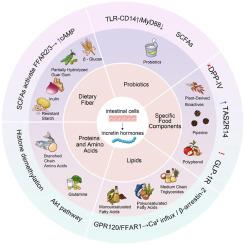肠促胰岛素轴的食物调节:糖尿病的分子机制和临床前景
IF 15.4
1区 农林科学
Q1 FOOD SCIENCE & TECHNOLOGY
引用次数: 0
摘要
糖尿病,尤其是2型糖尿病(T2DM),是一种以胰岛素抵抗、β细胞功能障碍和肠促胰岛素轴失调为特征的全球性代谢紊乱。肠促胰岛素激素(GLP-1和GIP)通过肠-胰岛轴对葡萄糖稳态至关重要,但它们的活性在2型糖尿病中受损,需要新的饮食干预。本文综述了天然食物成分(膳食纤维、脂类、氨基酸、益生菌、多酚、胡椒碱)如何调节肠促胰岛素轴的最新研究进展。分析了scfa介导的受体激活、DPP-IV抑制和肠道微生物群调节等机制,重点分析了分子途径和临床证据。主要发现和结论膳食纤维(如β-葡聚糖、菊糖)发酵成SCFAs(醋酸酯、丁酸酯),激活肠道L细胞上的FFAR2/3和GPR43,促进GLP-1分泌,改善T2DM患者血糖水平。脂质和某些氨基酸通过GPCR激活(如GPR120、FFAR1)和代谢途径(如α-KG、cAMP)调节肠促胰岛素。益生菌(如罗伊氏乳杆菌)和生物活性物质(多酚、胡椒碱)通过SCFA生成、胆汁酸信号传导或DPP-IV抑制来促进GLP-1。这些干预措施为T2DM管理提供了多靶点、低毒性的益处,并在联合(如合生剂)时具有协同效应。未来的研究应优先考虑使用多组学生物标志物和食品技术(如纳米递送)来提高生物利用度和个性化功效。本文章由计算机程序翻译,如有差异,请以英文原文为准。

Food regulation of incretin axis: Molecular mechanisms and clinical outlook in diabetes
Background
Diabetes, particularly type 2 diabetes mellitus (T2DM), is a global metabolic disorder characterized by insulin resistance, β-cell dysfunction, and incretin axis dysregulation. Incretin hormones (GLP-1 and GIP) are critical for glucose homeostasis via the gut-islet axis, but their activity is impaired in T2DM, necessitating novel dietary interventions.
Scope and approach
This review synthesizes current research on how natural food components (dietary fiber, lipids, amino acids, probiotics, polyphenols, piperine) modulate the incretin axis. Mechanisms including SCFA-mediated receptor activation, DPP-IV inhibition, and gut microbiota regulation are analyzed, with emphasis on molecular pathways and clinical evidence.
Key findings and conclusions
Dietary fibers (e.g., β-glucan, inulin) are fermented into SCFAs (acetate, butyrate) to activate FFAR2/3 and GPR43 on intestinal L cells, enhancing GLP-1 secretion and improving glycemia in T2DM. Lipids and certain amino acids modulate incretins via GPCR activation (e.g., GPR120, FFAR1) and metabolic pathways (e.g., α-KG, cAMP). Probiotics (e.g., Lactobacillus reuteri) and bioactives (polyphenols, piperine) promote GLP-1 through SCFA production, bile acid signaling, or DPP-IV inhibition. These interventions offer multitarget, low-toxicity benefits for T2DM management, with synergistic effects in combinations (e.g., synbiotics). Future research should prioritize precision nutrition using multi-omics biomarkers and food technologies (e.g., nanodelivery) to enhance bioavailability and personalized efficacy.
求助全文
通过发布文献求助,成功后即可免费获取论文全文。
去求助
来源期刊

Trends in Food Science & Technology
工程技术-食品科技
CiteScore
32.50
自引率
2.60%
发文量
322
审稿时长
37 days
期刊介绍:
Trends in Food Science & Technology is a prestigious international journal that specializes in peer-reviewed articles covering the latest advancements in technology, food science, and human nutrition. It serves as a bridge between specialized primary journals and general trade magazines, providing readable and scientifically rigorous reviews and commentaries on current research developments and their potential applications in the food industry.
Unlike traditional journals, Trends in Food Science & Technology does not publish original research papers. Instead, it focuses on critical and comprehensive reviews to offer valuable insights for professionals in the field. By bringing together cutting-edge research and industry applications, this journal plays a vital role in disseminating knowledge and facilitating advancements in the food science and technology sector.
 求助内容:
求助内容: 应助结果提醒方式:
应助结果提醒方式:


